Yitao Liang
Scalable Multi-Task Reinforcement Learning for Generalizable Spatial Intelligence in Visuomotor Agents
Jul 31, 2025Abstract:While Reinforcement Learning (RL) has achieved remarkable success in language modeling, its triumph hasn't yet fully translated to visuomotor agents. A primary challenge in RL models is their tendency to overfit specific tasks or environments, thereby hindering the acquisition of generalizable behaviors across diverse settings. This paper provides a preliminary answer to this challenge by demonstrating that RL-finetuned visuomotor agents in Minecraft can achieve zero-shot generalization to unseen worlds. Specifically, we explore RL's potential to enhance generalizable spatial reasoning and interaction capabilities in 3D worlds. To address challenges in multi-task RL representation, we analyze and establish cross-view goal specification as a unified multi-task goal space for visuomotor policies. Furthermore, to overcome the significant bottleneck of manual task design, we propose automated task synthesis within the highly customizable Minecraft environment for large-scale multi-task RL training, and we construct an efficient distributed RL framework to support this. Experimental results show RL significantly boosts interaction success rates by $4\times$ and enables zero-shot generalization of spatial reasoning across diverse environments, including real-world settings. Our findings underscore the immense potential of RL training in 3D simulated environments, especially those amenable to large-scale task generation, for significantly advancing visuomotor agents' spatial reasoning.
A Survey on Vision-Language-Action Models: An Action Tokenization Perspective
Jul 02, 2025Abstract:The remarkable advancements of vision and language foundation models in multimodal understanding, reasoning, and generation has sparked growing efforts to extend such intelligence to the physical world, fueling the flourishing of vision-language-action (VLA) models. Despite seemingly diverse approaches, we observe that current VLA models can be unified under a single framework: vision and language inputs are processed by a series of VLA modules, producing a chain of \textit{action tokens} that progressively encode more grounded and actionable information, ultimately generating executable actions. We further determine that the primary design choice distinguishing VLA models lies in how action tokens are formulated, which can be categorized into language description, code, affordance, trajectory, goal state, latent representation, raw action, and reasoning. However, there remains a lack of comprehensive understanding regarding action tokens, significantly impeding effective VLA development and obscuring future directions. Therefore, this survey aims to categorize and interpret existing VLA research through the lens of action tokenization, distill the strengths and limitations of each token type, and identify areas for improvement. Through this systematic review and analysis, we offer a synthesized outlook on the broader evolution of VLA models, highlight underexplored yet promising directions, and contribute guidance for future research, hoping to bring the field closer to general-purpose intelligence.
SciDA: Scientific Dynamic Assessor of LLMs
Jun 15, 2025Abstract:Advancement in Large Language Models (LLMs) reasoning capabilities enables them to solve scientific problems with enhanced efficacy. Thereby, a high-quality benchmark for comprehensive and appropriate assessment holds significance, while existing ones either confront the risk of data contamination or lack involved disciplines. To be specific, due to the data source overlap of LLMs training and static benchmark, the keys or number pattern of answers inadvertently memorized (i.e. data contamination), leading to systematic overestimation of their reasoning capabilities, especially numerical reasoning. We propose SciDA, a multidisciplinary benchmark that consists exclusively of over 1k Olympic-level numerical computation problems, allowing randomized numerical initializations for each inference round to avoid reliance on fixed numerical patterns. We conduct a series of experiments with both closed-source and open-source top-performing LLMs, and it is observed that the performance of LLMs drop significantly under random numerical initialization. Thus, we provide truthful and unbiased assessments of the numerical reasoning capabilities of LLMs. The data is available at https://huggingface.co/datasets/m-a-p/SciDA
Toward Memory-Aided World Models: Benchmarking via Spatial Consistency
May 29, 2025Abstract:The ability to simulate the world in a spatially consistent manner is a crucial requirements for effective world models. Such a model enables high-quality visual generation, and also ensures the reliability of world models for downstream tasks such as simulation and planning. Designing a memory module is a crucial component for addressing spatial consistency: such a model must not only retain long-horizon observational information, but also enables the construction of explicit or implicit internal spatial representations. However, there are no dataset designed to promote the development of memory modules by explicitly enforcing spatial consistency constraints. Furthermore, most existing benchmarks primarily emphasize visual coherence or generation quality, neglecting the requirement of long-range spatial consistency. To bridge this gap, we construct a dataset and corresponding benchmark by sampling 150 distinct locations within the open-world environment of Minecraft, collecting about 250 hours (20 million frames) of loop-based navigation videos with actions. Our dataset follows a curriculum design of sequence lengths, allowing models to learn spatial consistency on increasingly complex navigation trajectories. Furthermore, our data collection pipeline is easily extensible to new Minecraft environments and modules. Four representative world model baselines are evaluated on our benchmark. Dataset, benchmark, and code are open-sourced to support future research.
Inference-time Scaling of Diffusion Models through Classical Search
May 29, 2025Abstract:Classical search algorithms have long underpinned modern artificial intelligence. In this work, we tackle the challenge of inference-time control in diffusion models -- adapting generated outputs to meet diverse test-time objectives -- using principles from classical search. We propose a general framework that orchestrates local and global search to efficiently navigate the generative space. It employs a theoretically grounded local search via annealed Langevin MCMC and performs compute-efficient global exploration using breadth-first and depth-first tree search. We evaluate our approach on a range of challenging domains, including planning, offline reinforcement learning, and image generation. Across all tasks, we observe significant gains in both performance and efficiency. These results show that classical search provides a principled and practical foundation for inference-time scaling in diffusion models. Project page at diffusion-inference-scaling.github.io.
Plug-and-Play Context Feature Reuse for Efficient Masked Generation
May 25, 2025Abstract:Masked generative models (MGMs) have emerged as a powerful framework for image synthesis, combining parallel decoding with strong bidirectional context modeling. However, generating high-quality samples typically requires many iterative decoding steps, resulting in high inference costs. A straightforward way to speed up generation is by decoding more tokens in each step, thereby reducing the total number of steps. However, when many tokens are decoded simultaneously, the model can only estimate the univariate marginal distributions independently, failing to capture the dependency among them. As a result, reducing the number of steps significantly compromises generation fidelity. In this work, we introduce ReCAP (Reused Context-Aware Prediction), a plug-and-play module that accelerates inference in MGMs by constructing low-cost steps via reusing feature embeddings from previously decoded context tokens. ReCAP interleaves standard full evaluations with lightweight steps that cache and reuse context features, substantially reducing computation while preserving the benefits of fine-grained, iterative generation. We demonstrate its effectiveness on top of three representative MGMs (MaskGIT, MAGE, and MAR), including both discrete and continuous token spaces and covering diverse architectural designs. In particular, on ImageNet256 class-conditional generation, ReCAP achieves up to 2.4x faster inference than the base model with minimal performance drop, and consistently delivers better efficiency-fidelity trade-offs under various generation settings.
Redefining Superalignment: From Weak-to-Strong Alignment to Human-AI Co-Alignment to Sustainable Symbiotic Society
Apr 24, 2025Abstract:Artificial Intelligence (AI) systems are becoming increasingly powerful and autonomous, and may progress to surpass human intelligence levels, namely Artificial Superintelligence (ASI). During the progression from AI to ASI, it may exceed human control, violate human values, and even lead to irreversible catastrophic consequences in extreme cases. This gives rise to a pressing issue that needs to be addressed: superalignment, ensuring that AI systems much smarter than humans, remain aligned with human (compatible) intentions and values. Existing scalable oversight and weak-to-strong generalization methods may prove substantially infeasible and inadequate when facing ASI. We must explore safer and more pluralistic frameworks and approaches for superalignment. In this paper, we redefine superalignment as the human-AI co-alignment towards a sustainable symbiotic society, and highlight a framework that integrates external oversight and intrinsic proactive alignment. External oversight superalignment should be grounded in human-centered ultimate decision, supplemented by interpretable automated evaluation and correction, to achieve continuous alignment with humanity's evolving values. Intrinsic proactive superalignment is rooted in a profound understanding of the self, others, and society, integrating self-awareness, self-reflection, and empathy to spontaneously infer human intentions, distinguishing good from evil and proactively considering human well-being, ultimately attaining human-AI co-alignment through iterative interaction. The integration of externally-driven oversight with intrinsically-driven proactive alignment empowers sustainable symbiotic societies through human-AI co-alignment, paving the way for achieving safe and beneficial AGI and ASI for good, for human, and for a symbiotic ecology.
Generative Evaluation of Complex Reasoning in Large Language Models
Apr 03, 2025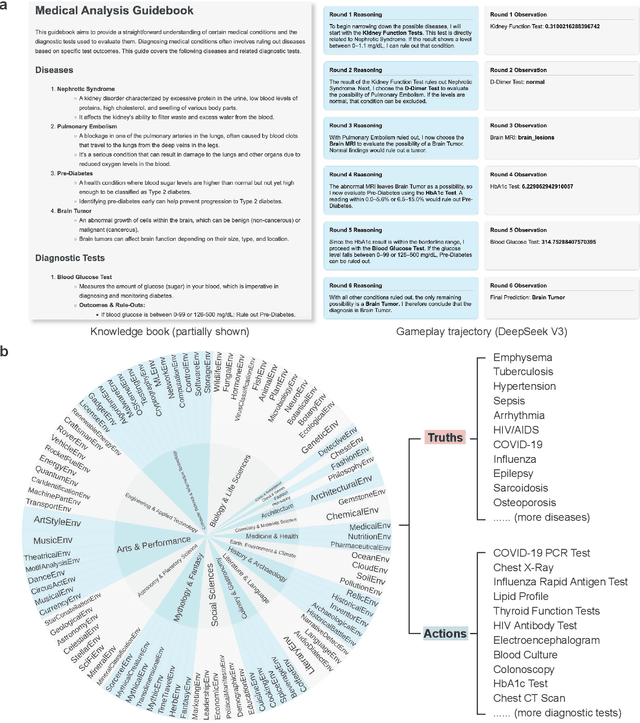
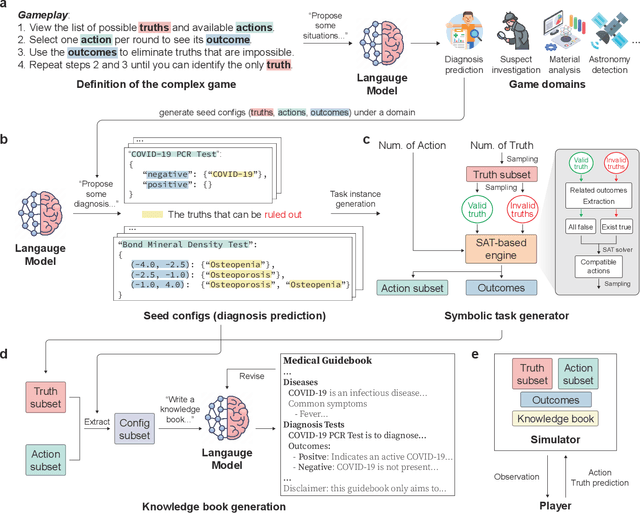
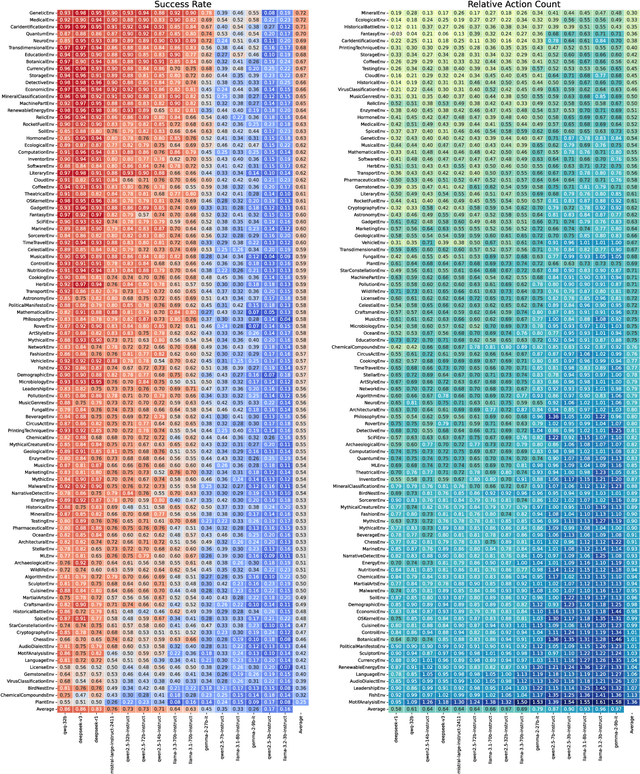
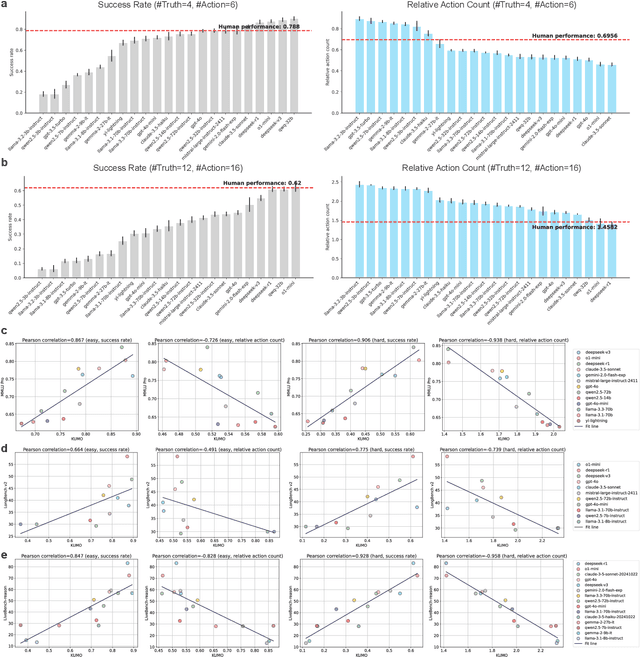
Abstract:With powerful large language models (LLMs) demonstrating superhuman reasoning capabilities, a critical question arises: Do LLMs genuinely reason, or do they merely recall answers from their extensive, web-scraped training datasets? Publicly released benchmarks inevitably become contaminated once incorporated into subsequent LLM training sets, undermining their reliability as faithful assessments. To address this, we introduce KUMO, a generative evaluation framework designed specifically for assessing reasoning in LLMs. KUMO synergistically combines LLMs with symbolic engines to dynamically produce diverse, multi-turn reasoning tasks that are partially observable and adjustable in difficulty. Through an automated pipeline, KUMO continuously generates novel tasks across open-ended domains, compelling models to demonstrate genuine generalization rather than memorization. We evaluated 23 state-of-the-art LLMs on 5,000 tasks across 100 domains created by KUMO, benchmarking their reasoning abilities against university students. Our findings reveal that many LLMs have outperformed university-level performance on easy reasoning tasks, and reasoning-scaled LLMs reach university-level performance on complex reasoning challenges. Moreover, LLM performance on KUMO tasks correlates strongly with results on newly released real-world reasoning benchmarks, underscoring KUMO's value as a robust, enduring assessment tool for genuine LLM reasoning capabilities.
JARVIS-VLA: Post-Training Large-Scale Vision Language Models to Play Visual Games with Keyboards and Mouse
Mar 20, 2025



Abstract:Recently, action-based decision-making in open-world environments has gained significant attention. Visual Language Action (VLA) models, pretrained on large-scale web datasets, have shown promise in decision-making tasks. However, previous work has primarily focused on action post-training, often neglecting enhancements to the foundational model itself. In response, we introduce a novel approach, Act from Visual Language Post-Training, which refines Visual Language Models (VLMs) through visual and linguistic guidance in a self-supervised manner. This enhancement improves the models' capabilities in world knowledge, visual recognition, and spatial grounding in open-world environments. Following the above post-training paradigms, we obtain the first VLA models in Minecraft that can follow human instructions on over 1k different atomic tasks, including crafting, smelting, cooking, mining, and killing. Our experiments demonstrate that post-training on non-trajectory tasks leads to a significant 40% improvement over the best agent baseline on a diverse set of atomic tasks. Furthermore, we demonstrate that our approach surpasses traditional imitation learning-based policies in Minecraft, achieving state-of-the-art performance. We have open-sourced the code, models, and datasets to foster further research. The project page can be found in https://craftjarvis.github.io/JarvisVLA.
A Neural Symbolic Model for Space Physics
Mar 11, 2025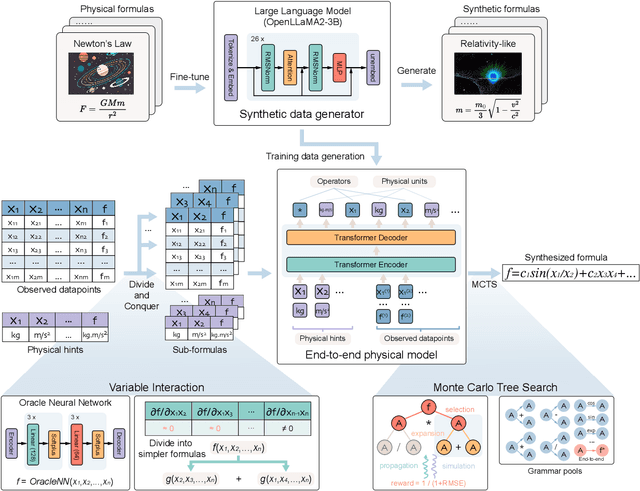
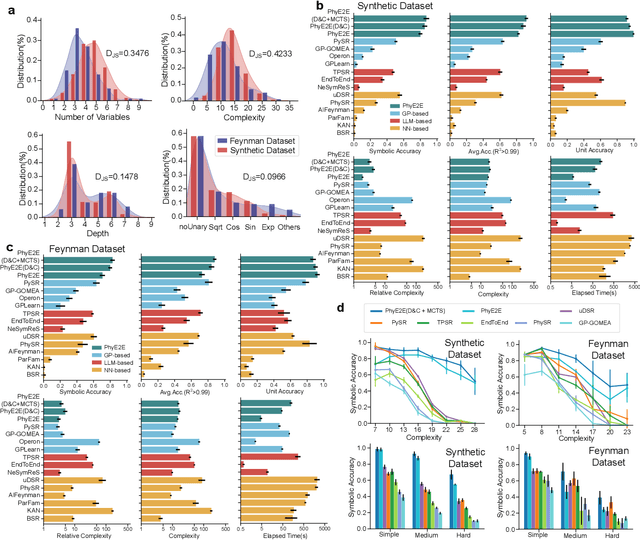
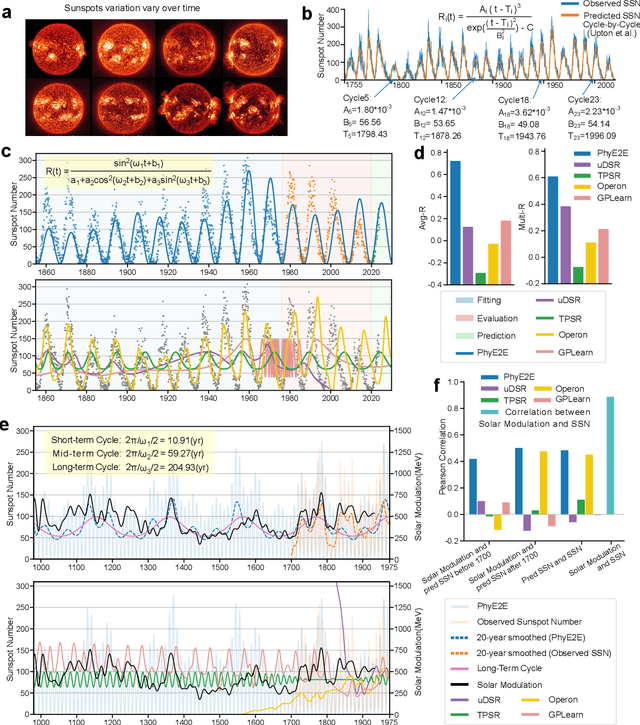
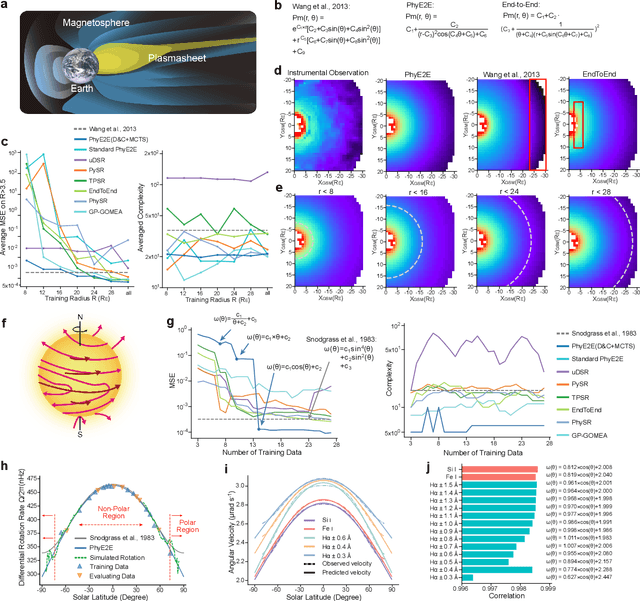
Abstract:In this study, we unveil a new AI model, termed PhyE2E, to discover physical formulas through symbolic regression. PhyE2E simplifies symbolic regression by decomposing it into sub-problems using the second-order derivatives of an oracle neural network, and employs a transformer model to translate data into symbolic formulas in an end-to-end manner. The resulting formulas are refined through Monte-Carlo Tree Search and Genetic Programming. We leverage a large language model to synthesize extensive symbolic expressions resembling real physics, and train the model to recover these formulas directly from data. A comprehensive evaluation reveals that PhyE2E outperforms existing state-of-the-art approaches, delivering superior symbolic accuracy, precision in data fitting, and consistency in physical units. We deployed PhyE2E to five applications in space physics, including the prediction of sunspot numbers, solar rotational angular velocity, emission line contribution functions, near-Earth plasma pressure, and lunar-tide plasma signals. The physical formulas generated by AI demonstrate a high degree of accuracy in fitting the experimental data from satellites and astronomical telescopes. We have successfully upgraded the formula proposed by NASA in 1993 regarding solar activity, and for the first time, provided the explanations for the long cycle of solar activity in an explicit form. We also found that the decay of near-Earth plasma pressure is proportional to r^2 to Earth, where subsequent mathematical derivations are consistent with satellite data from another independent study. Moreover, we found physical formulas that can describe the relationships between emission lines in the extreme ultraviolet spectrum of the Sun, temperatures, electron densities, and magnetic fields. The formula obtained is consistent with the properties that physicists had previously hypothesized it should possess.
 Add to Chrome
Add to Chrome Add to Firefox
Add to Firefox Add to Edge
Add to Edge